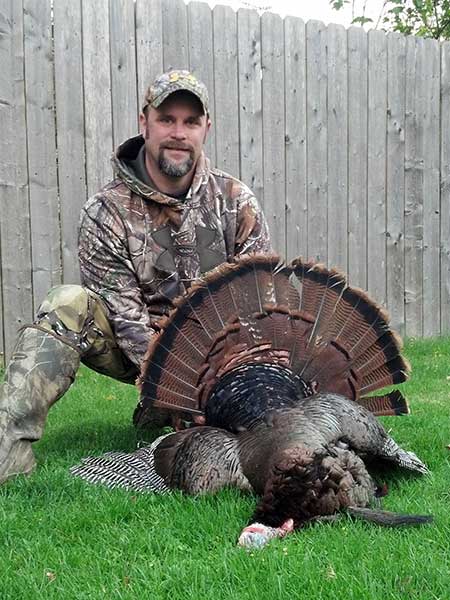By Louie Stout
 Ryan Hershberger used his Custom Calls to take this dandy bird from Michiana.Ryan Hershberger has put northern Indiana on the map in the minds of the nation’s avid turkey hunters.
Ryan Hershberger used his Custom Calls to take this dandy bird from Michiana.Ryan Hershberger has put northern Indiana on the map in the minds of the nation’s avid turkey hunters.
The Goshen entrepreneur received national honors for his hand-made turkey calls recently at the National Wild Turkey Federation Convention’s Call-Making competition.
Not only did he win first place in friction calls, but his call was cited as the Grand National Champion of all calls entered.
In other words, his calls sounded more realistic than all others in the competition.
Not bad for a guy who paints houses for a living and only has made turkey calls since 2007, just five years after he started hunting gobblers.
Hershberger specializes in old-school “trough calls” that consist of a rectangular box with slot in it for a striker. With striker in hand, the hunter scratches along the bottom of the call to emulate the clucks or yelps of hen turkeys wanting to mate.
His calls are made out of either cedar or walnut with either a slate or copper surface. The most popular are cedar with slate. He makes around 100 of them a year and sells them for $40 through local retailers or his facebook page, “Hersh’s Custom Calls.”
“I tune each one before it goes out,” said Hershberger, who spends a little over two hours building each call.
Hershberger learned his calling skills by stalking turkeys throughout northern Indiana and southwest Michigan.
“The birds have really come on the last five years,” he said. “They have learned to fit in with people, although not as much as deer. I’ve been seeing a lot of turkeys in the fields the past few years and the turkey hunting has gotten very popular.”
Turkeys use edges of crop fields for feeding but also like areas of acorns on ridge tops. Logging roads also can be prime hunting areas.
“It’s critical to scout properties and know the landscape before hunting there,” he explained. “When scouting, look for areas where the birds have fed and pay attention to places where they’ve scratched the ground, or for tracks or even feathers.”
Springtime is the preferred hunting season although fall turkey seasons are growing as well. During the spring when the birds are mating, hunters use calls to get the attention of the male birds and draw them to their hunting area. Most birds are hunted with shotguns.
Hershberger spends most of his time hunting birds on public land, some of the toughest birds to hunt because of the hunting pressure.
That’s where you will find him next few weeks. Michigan’s season opens Monday and Indiana kicks off April 27.
Hershberger has developed quite a reputation as a turkey hunter, conducting how-to seminars at area retailers that sell his calls.
“Most of my seminars are about hunting and calling birds on public land,” he said. “Those birds are usually shy and easily spooked, but they are very huntable if you put in the time and effort.”
 Hersh’s Custom Calls earned national honors from the National Turkey Federation.One of the biggest mistakes turkey hunters make, he added, is they use their calls too often or they give up on a gobbler too soon.
Hersh’s Custom Calls earned national honors from the National Turkey Federation.One of the biggest mistakes turkey hunters make, he added, is they use their calls too often or they give up on a gobbler too soon.
“If you get a bird to respond but he isn’t coming into you, be patient,” he explains. “Give yourself 60 minutes before you move on.”
Once a gobbler has responded to your call, be willing to wait at least five minutes before calling again.
“There is something to be said about being totally silent after the gobbler responds,” Hershberger said. “Let the bird stew. And when he starts coming in, use a mouth call to cluck occasionally to keep him focused. But don’t overdo it, unless he starts to lose interest.”




